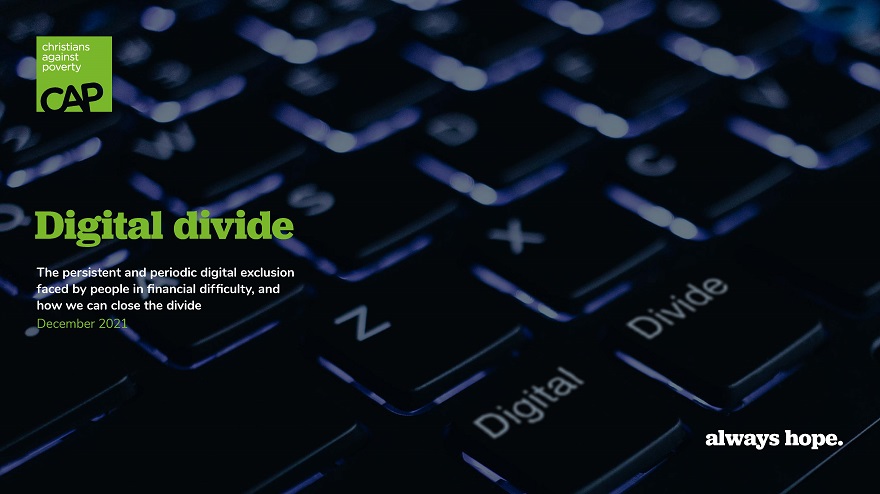Introduction
2.6 million people in the UK do not use the internet regularly. 14.9 million have very low levels of engagement (according to the Lloyds UK Consumer Digital Index).
People experience digital exclusion for a whole range of reasons, from the wide range and complexity of online tasks, to the cost of data and devices needed to access the internet.
This report presents data from CAP clients, as well as UK population data provided by Experian from Mosaic, to reveal the barriers that cause persistent and periodic digital exclusion – including capability and confidence, lack of access to devices and infrastructure, and the ongoing cost of internet data or a broadband connection.
Read the report

Key findings
1 in 4 CAP clients experience some degree of digital exclusion
1 in 4 CAP clients have limited digital engagement. Accessing a service and solving a problem online are the tasks most people find difficult.
Digital exclusion can be persistent or periodic
As well as persistent digital exclusion due to not having a device with internet access, or online services being inaccessible, 1 in 4 experience periodic exclusion, which stops them doing certain things online or at certain points in time.
- 15%of CAP clients have never accessed a service online
- 18%of CAP clients find solving a problem online difficult or very difficult, or never do this
- 24%of CAP clients can only access the internet via a smartphone
- 9%of CAP clients have faced a financial barrier that stopped them using the internet
Digital exclusion has a range of causes, including financial barriers
The type of barriers people face affects which online tasks they find difficult. It is low income households, single parents and people in receipt of means-tested benefits who experience financial barriers the most.
- 98% of people who can’t afford enough data on their phone faces vulnerability factor.
- 85% of people who are unable to afford a broadband contract are in receipt of a means-tested benefit.
Recommendations
There is important work taking place to increase inclusion by removing the barriers that stop people using the internet in their lives and work.
However, non-digital alternatives are still important as they allow everyone to participate more fully in society. Firms and Government are able to mitigate the gap so that people are not penalised by a ‘digital world’ that they cannot benefit from.
For this, we recommend the following design principles:
No sudden cut-off. Telecommunications firms should provide more forbearance and affordable catch-up plans before cutting off services to customers in arrears on data contracts.
No blacklisting. Telecommunication companies should base affordability assessments on the current financial situation of a customer. They should not automatically exclude or charge a premium to people because of a previous bankruptcy, County Court Judgment or when applying for a contract.
Zero-rate the essentials. Essential and Government services should work with telecommunications firms to allow free access on mobile devices to web pages needed to access key services like Universal Credit, debt advice and support for self-disconnection.
Inclusive design. Firms and public services should take into account the needs of people who are facing digital exclusion when designing and pricing products and services.
Design for mobile. Digital services should be designed to be easily completed by people using a mobile device. All tasks that can be completed via internet banking should be built into firms’ mobile applications.
Omni-channel by default. Firms should allow customers to switch between communication channels, allowing for easier access depending on their evolving needs and circumstances.
Enable third party support. Digital journeys shouldn’t rely on self-service only. Instead, they should mirror face-to-face and telephone services in enabling third parties to easily support people who need extra help to engage.
Offer help. Firms can support the digital inclusion of their customers by being a trusted source of support and help for digital questions, especially about accessing services and making payments online.





